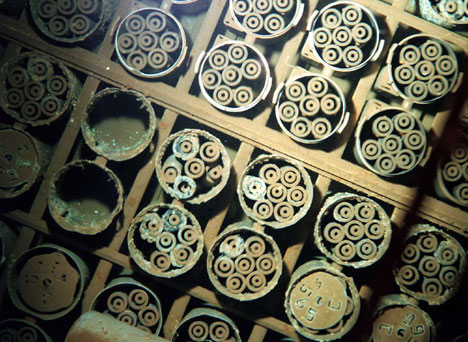I have discussed spent nuclear fuel in a number of previous posts. I just encountered a study that deals with the current spent fuel rods inventory in the United States and the dangers that it poses. I thought that it would be worthwhile to recap the findings in the study.
Nuclear reactors employ fuel rods which are steel alloy tubes containing ceramic pellets of enriched uranium. These rods are combined into assemblies of a few hundred and then loaded into the core of a reactor. When the uranium has been depleted to the point where it can no longer server as fuel, the rods are removed from the reactor and stored in a pool of water for a year or more until they become less radioactive. When first removed from the reactor, a typical fuel rod gives off enough radiation to kill a nearby person in seconds. Even after several years of cooling, the rods as still very dangerous.
The United States has accumulated about 30 million spent fuel rods in the decades of commercial reactor operation. This is about sixty five thousand metric tons of fuel rods. Currently, seventy five percent of the spent fuel rods are stored in the cooling pools near the reactors. About forty percent of the radioactivity in the spent fuel rods is cesium-137. The amount of cesium in the U.S. fuel rod inventory is about twenty times the amount released by all the atmospheric tests of nuclear bombs. This is also about twenty times the amount of cesium-137 released by the Chernobyl accident. A single pool at a U.S. reactor may hold more fuel rods than the combined pools of the reactors damaged at Fukushima last year. The rods in just one of the Fukushima pools are considered a major threat to the world if the cooling system fails.
These spent fuel rod pools were only ever meant to be temporary storage with the intention being to move the rods to a permanent geological repository like the one planned for Yucca Mountain in Nevada. Unfortunately, Yucca Mountain got derailed by a combination of political and environmental factors. These pools are constructed form ordinary building materials. While they are protected from the weather, they are not secure from more dangerous threats such as major storms, earthquakes or terrorist attacks. There are thirty one U.S. reactors which have spent fuel pools several stories above the ground like the Fukushima fuel pools which are in danger of collapsing from structural damage. They do not have steel-lined concreted covers like the reactor vessels. Another sixty nine U.S. pools are not multiple stories above the ground but they also do not have steel-lined, concrete covers.
In the last thirty years, U.S. reactors have temporarily lost a large portion of their cooling water for spent nuclear fuel pools. If the rods are exposed to the open air, they will spontaneously burn. There have been eleven incidents since 911 after which the pools were supposed to be made more secure and safer. There are systems in place in the spent fuel pools to prevent a chain reaction from taking place. Corrosion has damages some of these systems in some pools to the point where chain reactions would not be prevented. Fuel rods are being used that have a higher proportion of U-235 and burn hotter than the older rods. The new rods are more radioactive when they are removed from the reactor and they are overloading the cooling systems in the spent fuel pools. The hotter fuel in the new rods can cause the shell of the rod to become brittle and also generate more hydrogen gas which could lead to explosions.
Many reactors are near major cities in the U.S. If there was a major accident involving spent fuel rods, it could require the evacuation of millions and the abandonment of large urban areas. Thousands of deaths from cancer would result. The damages would run into the hundreds of billions of dollars. The U.S. should immediate begin placing all fuel rods older than five years in dry casks. The cost would be a few billion dollars which is a small price to pay considering the enormous cost in dollars and lives a major accident would cause. These spent fuel pools a major threat to millions of Americans and should be dealt with immediately!
Spent nuclear fuel at Hanford, WA:
